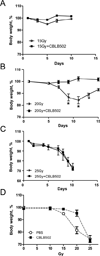Toll-like receptor 5 agonist protects mice from dermatitis and oral mucositis caused by local radiation: implications for head-and-neck cancer radiotherapy
- PMID: 22000579
- PMCID: PMC3261342
- DOI: 10.1016/j.ijrobp.2011.05.055
Toll-like receptor 5 agonist protects mice from dermatitis and oral mucositis caused by local radiation: implications for head-and-neck cancer radiotherapy
Abstract
Purpose: Development of mucositis is a frequent side effect of radiotherapy of patients with head-and-neck cancer. We have recently reported that bacterial flagellin, an agonist of Toll-like receptor 5 (TLR5), can protect rodents and primates from acute radiation syndrome caused by total body irradiation. Here we analyzed the radioprotective efficacy of TLR5 agonist under conditions of local, single dose or fractionated radiation treatment.
Methods and materials: Mice received either single-dose (10, 15, 20, or 25 Gy) or fractioned irradiation (cumulative dose up to 30 Gy) of the head-and-neck area with or without subcutaneous injection of pharmacologically optimized flagellin, CBLB502, 30 min before irradiation.
Results: CBLB502 significantly reduced the severity of dermatitis and mucositis, accelerated tissue recovery, and reduced the extent of radiation induced weight loss in mice after a single dose of 15 or 20 Gy but not 25 Gy of radiation. CBLB502 was also protective from cumulative doses of 25 and 30 Gy delivered in two (10 + 15 Gy) or three (3 × 10 Gy) fractions, respectively. While providing protection to normal epithelia, CBLB502 did not affect the radiosensitivity of syngeneic squamous carcinoma SCCVII grown orthotopically in mice. Use of CBLB502 also elicited a radiation independent growth inhibitory effect upon TLR5-expressing tumors demonstrated in the mouse xenograft model of human lung adenocarcinoma A549.
Conclusion: CBLB502 combines properties of supportive care (radiotherapy adjuvant) and anticancer agent, both mediated via activation of TLR5 signaling in the normal tissues or the tumor, respectively.
Copyright © 2012 Elsevier Inc. All rights reserved.
Conflict of interest statement
Lyudmila Burdelya, Elena Feinstein and Andrei Gudkov are paid consultants of Cleveland BioLabs, Inc., which develops CBLB502 into radiation countermeasure. Corresponding author, Dr. Andrei Gudkov, is a shareholder of Cleveland BioLabs, Inc. This work was funded in part by a research grant from Cleveland BioLabs, Inc. to Roswell Park Cancer Institute (principle investigator – Dr. Andrei Gudkov).
Figures



References
-
- Rosenthal DI, Trotti A. Strategies for managing radiation-induced mucositis in head and neck cancer. Semin Radiat Oncol. 2009;19:29–34. - PubMed
-
- Vitolo JM, Cotrim AP, Sowers AL, et al. The stable nitroxide tempol facilitates salivary gland protection during head and neck irradiation in a mouse model. Clin Cancer Res. 2004;10:1807–1812. - PubMed
-
- Vissink A, Burlage FR, Spijkervet FK, et al. Prevention and treatment of the consequences of head and neck radiotherapy. Crit Rev Oral Biol Med. 2003;14:213–225. - PubMed
-
- Nagler RM, Baum BJ. Prophylactic treatment reduces the severity of xerostomia following radiation therapy for oral cavity cancer. Arch Otolaryngol Head Neck Surg. 2003;129:247–250. - PubMed
-
- Russo G, Haddad R, Posner M, et al. Radiation treatment breaks and ulcerative mucositis in head and neck cancer. Oncologist. 2008;13:886–898. - PubMed
Publication types
MeSH terms
Substances
Grants and funding
LinkOut - more resources
Full Text Sources
Other Literature Sources
Medical

